The Top 18 Dragons Who Aren’t Smaug
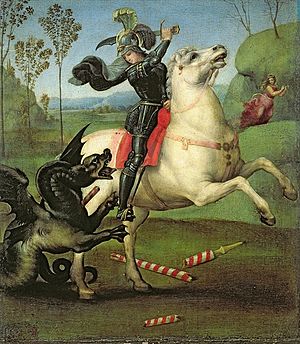 |
Look, in the world of Nerdery, dragons are a pretty big deal. They’re among the archetypical monsters of the human narrative tradition; something that passes for a dragon can be found in the folklore of peoples from all parts of the world. They’re in both the Asian and Western zodiac, and the Archangel Michael and St. George each famously kicked a dragon’s ass. And they hold a special place in the hearts of nerds, in fiction ranging from Eddison’s Worm Ouroboros to the Chronicles of Narnia to Game of Thrones, and movies from Dragonheart to Reign of Fire to Eragon. They are, for that matter, what just naturally comes after the phrase “Dungeons and…”
But even within the world of Dragon-dom, Smaug is a pretty big deal. Indeed, the hoarder dragon from Tolkien’s The Hobbit is the all-but-undisputed heavyweight champ of his kind. He was depicted fairly well in the 1977 Rankin-Bass animated version of the tale, voiced by the oddly but effectively cast western star Richard Boone. But he has now been realized, almost more spectacularly than could have been hoped for, in Peter Jackson’s current The Hobbit: The Desolation of Smaug.
So even if Jackson’s movie has fallen short of last year’s Hobbit at the box office, it still seems like an auspicious time to recognize a few of Smaug’s runners-up. But understand that I’m well aware that this is a personal, whatever-comes-to-mind list, and that even if it ran to 30, 50 or a hundred examples, there would still be entirely worthy dragons omitted. The dragons here, however, though rooted in classical mythology or literature, have all been through the pop culture filter – movies, TV, comics, video games. To make this list, in other words, a dragon has to be a commercial sell-out.
18. Fritz Lang’s Fafnir
Dragons go way back in the history of the cinema. Earlier specimens could be probably be found, but at least as early as 1911 a lively fire-breathing dragon was among the title specters in the Georges Melies film Les hallucinations du Baron Munchhausen, and Douglas Fairbanks fights a nasty one in 1924’s The Thief of Bagdad.
Maybe the most memorable dragon of the silent era, however, is Fafnir, battled by Siegfried (the legendary hero, not the Get Smart villain) in Part One of Die Nibelungen, Fritz Lang’s epic two-part version of Teutonic myth. Perhaps because he is, apparently, a full-sized mock-up, the Fafster’s not very mobile, and doesn’t seem able to fight back very well, which makes Siegfried’s unprovoked attack seem sort of mean.
This sympathetic reaction may be exacerbated for modern audiences for whom, it must be admitted, the beast’s head can bear a regrettable resemblance to Ollie from Kukla, Fran and Ollie.
17. The Reluctant Dragon
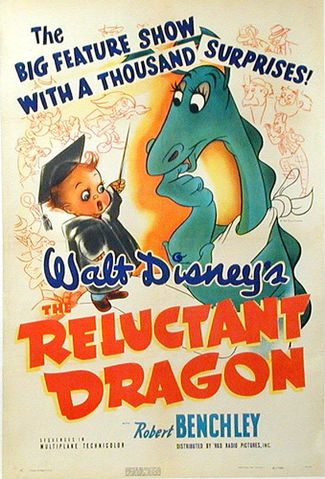 |
The title character of this odd 1941 Disney feature – a behind-the-scenes tour of the studio with animated segments mixed in – was drawn from a short story in the 1898 book Dream Days, by Kenneth Grahame of Wind in the Willows fame. It concerns a shepherd’s bookish son who learns that there’s a dragon living on the Downs near his home.
His father gives the beast a highly evocative description: “He was as big as four cart-horses, and all covered with shiny scales – deep-blue scales at the top of him, shading off to a tender sort o’ green below. As he breathed, there was that sort of flicker over his nostrils that you see over our chalk roads on a baking windless day in summer.“
But when the boy investigates, he finds that the dragon belies his majestic appearance. He’s a friendly sort, but effete and blas?, with a turn for poetry and no interest in behaving as other dragons do: “…always rampaging, and skirmishing, and scouring the desert sands, and pacing the margin of the sea, and chasing knights all over the place, and devouring damsels, and going on generally – whereas I liked to get my meals regular and then to prop my back against a bit of rock and snooze a bit…“
It’s a good joke, and there have been numerous adaptations of it besides Disney’s, including a Grahame-inspired ’70s TV cartoon, The Reluctant Dragon and Mr. Toad Show. But it was probably also the origin of the Boy-and-his-Dragon stories that have become so popular in this past century, with such specimens as Elliot from Pete’s Dragon (1977), and H.R. Pufnstuf, and…
16. Puff
Reputedly a magic dragon, Puff is said to have resided in a coastal area in the land of Honalee, where he was known to have capered in the hazy weather common in that region in the Fall of the year. Puff’s closest associate is said to have been one Jackie Paper, who allegedly indulged his friend with lavish gifts.
Peter Yarrow of Peter, Paul and Mary adapted a poem by a college acquaintance, Leonard Lipton (itself reportedly inspired by the 1936 Ogden Nash poem “The Tale of Custard the Dragon”), into a folk song which the trio recorded in 1961, thus creating perhaps the most familiar mainstream dragon of the 20th Century. The song has a stingingly unsentimental ending in which Jackie puts aside childish things, leaving his scaly pal bereft. It’s always struck me that, in this era of arrested development, Puff needn’t have been sad; Jackie would eventually have tracked him down on eBay.
For most of its existence, “Puff” has been dogged by the belief that it was intended as an allegory for marijuana use, and how it inevitably leads to harder stuff (the same notion attached itself to H.R. Pufnstuf). Yarrow has always irritably denied this, at one point reportedly snapping “When ‘Puff’ was written, I was too innocent to know about drugs. What kind of a meanspirited SOB would write a children’s song with a covert drug message?“
15. Falkor
Another prize specimen of Boy-and-his-Dragon is the “luck dragon” that befriends the heroic Atreyu in The NeverEnding Story. In Wolfgang Petersen’s much-loved 1984 movie version of Michael Ende’s novel and its sequels, Falkor isn’t scaly and reptilian; he’s depicted as a white-furred and somewhat doglike beast, with a rumbling yet warm speaking voice provided by Alan “Skeletor” Oppenheimer.
Falkor can fly, and at one point or another in the movie he’s ridden by both Atreyu and the hero of the story-outside-the-story, Bastian Bux. Mounted aerial transportation is a potent childhood fantasy, but Falkor’s greatest wish-fulfillment for kids is simply his friendship. Or maybe it’s flying first, friendship second, scaring bullies third. Or maybe it’s scaring bullies first, then flying, then friendship…
OK, one more Boy-and-his-Dragon…
14. Spot
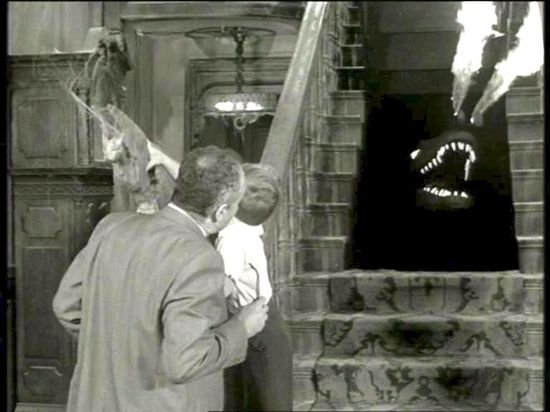 |
Eddie Munster’s faithful pet on The Munsters (1964-1966) was a roaring, fire-breathing dragon who lived under the stairs. It’s said that Spot’s dimly-visible head – maddeningly dimly visible, when you were a kid – was a recycling of the T-Rex head from 1957’s The Land Unknown, and that’s sure what it looks like. We also occasionally saw his tail, his footprints, or his silhouette, but in general he was camera-shy.
Probably Spot’s juiciest half-hour on the show was the second-season episode “Underground Munster,” in which Herman, forced to discipline Spot for tracking quicksand into the house, gives his enormous scaly tail the tiniest tap with a rolled-up-newspaper, at which the poor beast flees the house in terror. He takes to the sewers, and Herman must go there to search for him.
Incidentally, it’s now possible to buy, from the official Munsters website, an official Spot house key.
13. Haku
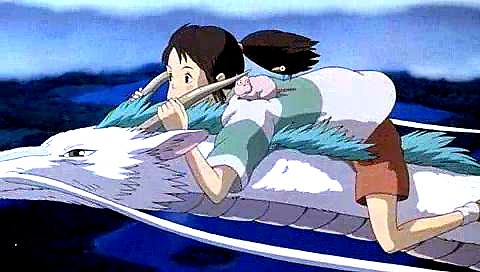 |
Girl-and-her-Dragon has not, as yet, proved as common a motif as Boy-and-his-Dragon. But in Hayao Miyazaki’s 2001 mastrepiece Spirited Away, the heroine’s pal Haku sometimes takes the form an exquisite white dragon. She even gets to ride him.
He’s not altogether dissimilar to Falkor, really…
12. Fin Fang Foom
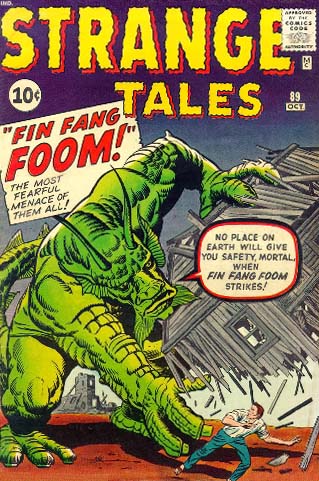 |
In the October 1961 issue of Strange Tales, this sleeping dragon was awakened by a resourceful lad and sicced on a camp of Red Chinese invaders, then successfully put back to sleep through the use of herbal medicine. He’s been awakened many times since, however, and has tangled with such Marvel notables as the Fantastic Four and Iron Man.
Over the course of these subsequent adventures, we’ve learned that he’s a native of the planet Kakaranthara, and that his impressive moniker translates as “He whose limbs shatter mountains and whose back scrapes the sun.” In actuality, FFF’s creator Stan Lee claims that the monster’s alliterative name derived from the title Chu Chin Chow, a ’30s-era movie version of the famed English musical play that had stuck in Lee’s head since he was a kid.
Here’s another one from the comics…
11. Andar’s Bad Trip
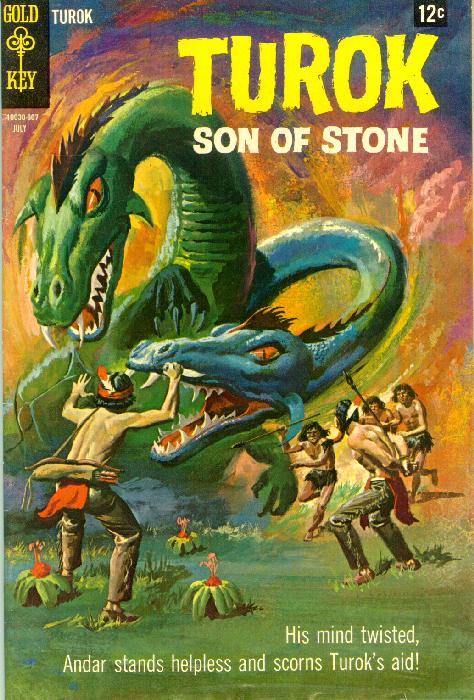 |
This two-headed horror graced the cover of issue #62 (July 1968) of Turok, Son of Stone, which chronicled the adventures of Turok and his young friend Andar, indigenous Americans who’ve wandered into a “Lost Valley” of dinosaurs and pronoun-challenged cavemen.
In the story, the dragon turns out to be a hallucination by Andar, who is tripping under the influence of some local flora. It’s none-too-subtle anti-drug propaganda. As I recall, I found it a cheat as a kid that the promised beast was just an illusion. Sure is a cool painting, though.
The collected Gold Key Turok adventures are being re-published in hardcover “Archive” editions by Dark Horse comics. This issue may be found in Volume #10.
10. Singe
Introduced in 1983, the arcade favorite Dragon’s Lair, designed by animator Don Bluth, featured this Smaug-like sort: He slept on a stash of gold coins, and breathed fire. Unlike Smaug, however, Singe was the stooge of evil Mordroc, for whom he had abducted the nubile Princess Daphne. Her rescuer – the player’s surrogate – was the set-jawed but not-always-unflappable Dirk the Daring.
Maybe even cooler than Singe’s depiction in the game is his incarnation as an action figure, however:
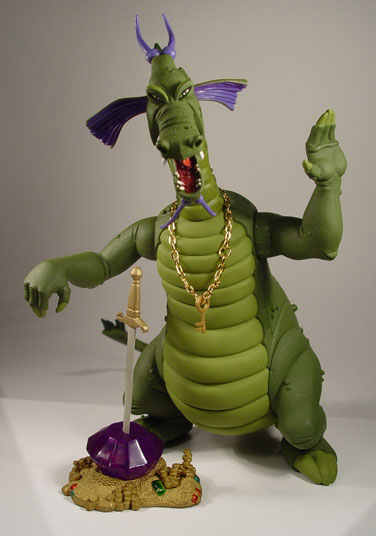 |
9. Ender Dragon
We could hardly leave the subjects of either video games or toys without a nod to the Ender Dragon, scourge of the cube-assembling game Minecraft. The dreaded geometrical nightmare is available both in virtual form and in Lego form.
The only question is: Does a game in which the Ender Dragon prevails constitute an Ender’s Game?
8. The White Worm
Lair of the White Worm, Bram Stoker’s feverish final novel of 1911 was inspired by the northern-England legend of the Worm of Lambton. Ken Russell’s 1988 adaptation is a lightweight but genuinely witty little film, maybe my favorite of Russell’s works, formidable though The Devils (1971) is. White Worm‘s imagery is sexy in a marvelously adolescent way, Amanda Donohoe is unforgettable as the seductive but lethal snake-woman, and there are charming early performances by Peter Capaldi and Hugh Grant, posh and self-deprecating as ever, as the young heroes.
By far the best thing in the movie, however, is the song linked to above, and the white dragon that joins the party mid-number to be dispatched by Grant, with characteristic sheepishness.
7. Yosemite Sam’s Dragon
Sam, cast as the Black Knight in 1958’s “Knighty Knight Bugs,” had a henchdragon who seemed to be trying hard, but whose tendency to sneeze proved a recurrent problem. The perennial Bugs antagonist is ultimately moved to pronounce a blanket judgment: “Dragons is so stupid.“
“Knighty Knight Bugs,” by the way, won the Oscar for Best Animated Short. Outrageously, it was the first, and more outrageously it is to date the only, Bugs Bunny cartoon to do so. It’s the entire basis, therefore, for Bugs’ billing as “that Oscar-winning rabbit.“
6. The Tic-Tac-Dough Dragon
This behemoth bedeviled the tactical warriors who played the late-’70s-to-mid-’80s version of the game show favorite, hosted by Wink Martindale. Initially, the object of the “Beat the Dragon” bonus round was, obviously, to avoid the Dragon’s visage. Later in the run, however, contestants pulled from the audience were invited to boldly “Find the Dragon.”
5. Sokura’s Gate Guard
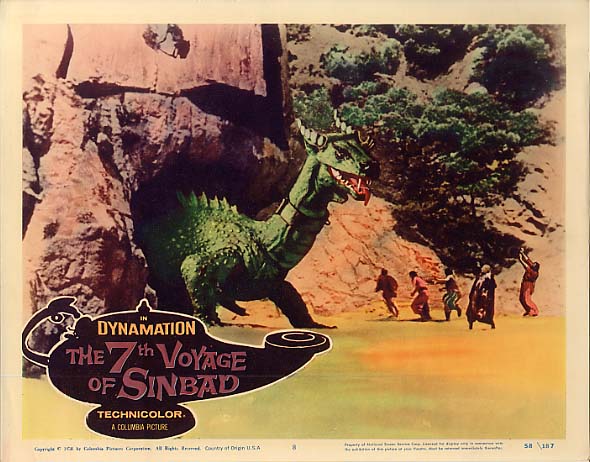 |
The honored art of stop-motion animation has given us a number of fine traditional dragons, like the one into whom the evil wizard transforms himself at the cliamx of 1962’s Jack the Giant Killer, or the gaudy, jeweled specimen taken on by Terry-Thomas and Buddy Hackett in The Wonderful World of the Brothers Grimm (also 1962).
But no stop-motion dragon can match the beauty (animated by Ray Harryhausen) who’s chained up at the entrance to the lair of the wicked wizard Sokura (Torin Thatcher) in The 7th Voyage of Sinbad (1958), but who is loosed at the climax and wrestles with the Cyclops. This behemoth always struck me as sweetly canine in the way he ambles along behind his maniacal master.
4. Q (1982)
Stop-motion was also responsible for the onscreen realization of a Pre-Columbian American dragon, Quetzalcoatl, Q for short, the title character of Larry Cohen’s erratic, preposterous, brilliantly-acted Manhattan fantasy. Neurotic small-time crook Michael Moriarty – in, no joke, one of his very best performances – stumbles upon the knowledge that this Aztec deity is roosting (and nesting!) in the spire of the Chrysler building. Toward the end, there’s a battle between New York’s finest, hanging off the side of the building, and Q, swooping around them on the wing; sort of like King Kong in reverse.
Star Trek: The Animated Series, offered us a pretty nice version of the Mayan variation of this god, Kukulkan, in the second-season episode “How Sharper Than a Serpent’s Tooth”:
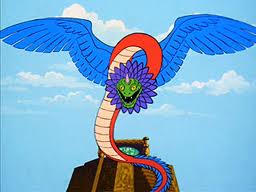 |
3. Maleficent
Along with the Reluctant One (see above) and Pete’s companion, Disney has offered many dragons over the decades, from the nattering Chinese dracunculus voiced by Eddie Murphy in Mulan to the grand terror that Susan Sarandon turns into at the climax of Enchanted. But who is likely to argue that the most ass-kicking of Disney’s dragons is the sleek, black, stylized serpent into which the evil Maleficent transforms herself at the end of Sleeping Beauty (1959)?
Imposing as she is in the film (especially, as in his clip, in French), it’s in her role in the “Disney Princess” version of the card game Uno, which I occasional play with (and at which I am usually defeated by) my kid, by which I’ve been most outraged by Maleficent, or rather by Disney’s apparent containment policy toward her.
Here’s the problem: Most of the cards feature one or another of the various Disney Princesses – Snow White, Belle, Jasmine – but occasionally one’s opponent plays a Dragon Card, depicting the Sleeping Beauty dragon.
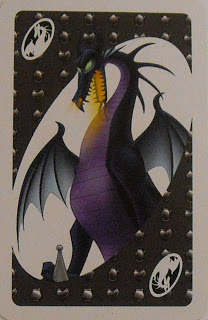 |
Confronted with this beast, one must discard, or draw from the deck until one finds, a card depicting a Princess in the clinch with her designated Prince, such cards being called “Dragonslayers.”
Now, this strikes me as suggesting to the young players that you need a man around for whatever dragon shows up in your life, that you’re powerless to pick up a sword & slay the freakin’ dragon yourself. Doesn’t it? Or am I just being excruciatingly politically correct?
2. The Imoogi
The 2007 Korean production Dragon Wars: D-War, set and at least partly shot in the USA, was an instant so-bad-it’s-good classic. It involves a pair of star-crossed lovers – Jason Behr and Amanda Brooks, who look like they grew right out of a compost heap of theatre-major head shots – caught up in the return to Earth of an army of legendary Korean dragon-serpents, the Imugi, or “Imoogi” as they’re spelled in the subtitles. These two crazy mixed-up kids soon learn that they’re reincarnations of a pair of lovers from medieval Korea who also have a history with dragons.
The dialogue is eye-wideningly terrible, as is most of the acting by the largely American cast. Keenest sympathies are reserved for that sterling actor Robert Forster, who plays a sage antique dealer and who has the unenviable task of delivering pages and pages of expository narration. He sounds like he’d rather be just about anywhere else on the planet.
The dragon themselves, however, are quite wonderful. The computer-generated special effects are near-seamless, and the director, Hyung-rae Shim, has a real flair for large-scale spectacle. When the snaky, furious-faced beasts loom over tree lines or coil themselves around skyscrapers, or when flocks of leathery-winged monsters endlessly dogfight with helicopters, the movie generates a wild-and-wooly energy that few attempts at gargantuan fantasy have equaled. The dragon designs have a mythic beauty to them, too; when a good dragon finally shows up to defend the young lovers – “It’s the good Imoogi!” our hero helpfully observes – it has the ornate elegance we want from an Asian specimen of dragon, and its clash with the “bad Imoogi” looks like a Molly Hatchet album cover come to life.
1. Vermithrax Pejorative
But if we must pick a single greatest non-Smaug dragon of the modern era, I would argue that it might just be the virgin-gobbling bane from the fine, full-blooded 1981 fantasy Dragonslayer. I haven’t seen the film since the ’80s – when I saw it repeatedly – and I’m a little reluctant to: I’m afraid that Vermithrax won’t have aged as well as she has in my memory. She was traditional in form but innovative, and entirely convincing, in execution; a mixture of full-sized animatronic pieces and Phil Tippet’s “go motion” technique, which added movement to the single-frame takes, thus smoothing out the familiar “jerkiness” of stop-motion.
VP was commanding aurally as well as visually. Few who have seen the movie can forget (spoiler!) her terrible wail of enraged grief when she discovers that her nest has been violated. Here, as with most great monsters, our fright at her is complicated by empathy.
Previous articles by M.V. Moorhead:
The Ten Least Intimidating, Supposedly Powerful Robots in Sci-Fi
The Top Ten Pop-Culture Cavemen Who Aren’t the Flintstones (or the Croods)
The Ten Nerdiest Modern Shakespeare Adaptations
The Thirteen Greatest Fictional Snails
The Ten Best Fantasy/Sci-Fi/Horror Novels You’ve Probably Never Read
